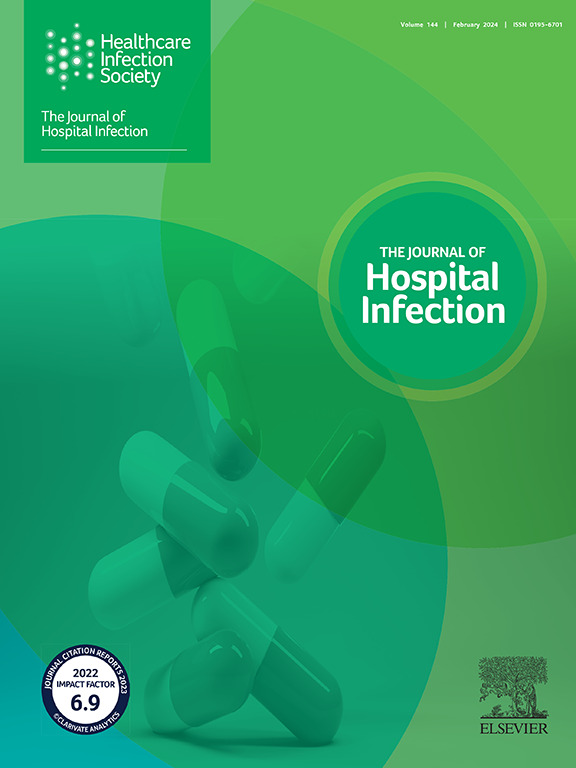Optimization and evaluation of new decontamination procedures inactivating human prions
IF 3.9
3区 医学
Q1 INFECTIOUS DISEASES
引用次数: 0
Abstract
Background
Prions are protein-only infectious agents for which no prophylactic or curative treatment exists. There is a need for formulations effective against human prions and robust in-vitro and in-vivo evaluation protocols.
Aim
To compare infectivity bioassays with those of their protein misfolding cyclic amplification (PMCA) counterparts to propose a robust method for evaluating prionicide treatments against human prions.
Methods
Stainless steel wires were contaminated with two humanized prion strains. The wires were then treated with different protocols based on a new formulation termed TFD Premium and World Health Organization (WHO) references. Residual prion seeding activity and infectivity on the wire and in wastewater were quantified using mb-PMCA and ad-hoc bioassays. For vCJD, PMCA compared humanized prions and a human-derived prion isolate.
Findings
TFD Premium was more efficient at decontaminating humanized prions than 1 N NaOH for 1 h at room temperature. Tg650-sCJD-VV2 was more resistant to inactivation than vCJD prions. For vCJD, strain from both sources showed similar resistant profile against TFD Premium. Finally, there was perfect alignment between the highly sensitive PMCA cell-free assay and the bioassays.
Conclusion
This study identified a new formulation called TFD Premium, which outperforms or equals the WHO reference methods against human prions and is suitable for manual and automated reprocessing of medical devices in healthcare facilities.
使人类朊病毒失活的新型去污程序的优化和评价。
背景:朊病毒是一种单纯的蛋白质感染性病原体,目前尚无预防或治疗方法。基于仓鼠- 263k朊病毒的传染性生物测定,可用于识别能够灭活医疗设备上的朊病毒的过程。然而,2016年发表的一项研究显示,对仓鼠菌株有效的洗涤剂配方对人类菌株的效果很差。不久之后,三起可能的意外克雅氏病病例强调了暴露于污染物质的科学家、卫生工作者和患者的风险。政府指南进行了修改,并强调需要有效对抗人类朊病毒的配方和健全的体外和体内评估方案。在这里,我们的目的是比较感染性生物测定与它们的PMCA对应的方法,以提出一种可靠的方法来评估杀朊病毒治疗对人类朊病毒的作用。方法:用两株人源朊病毒感染不锈钢丝。然后根据一种称为TFD Premium的新配方和世卫组织参考文献,用不同的方案处理导线。利用mb-PMCA和特设生物测定法定量测定了金属丝和废水中残留的朊病毒播种活性和传染性。对于vCJD, PMCA比较了人源朊病毒和人源朊病毒分离物。结果:TFD Premium在室温下净化人源朊病毒1小时的效率高于1n NaOH。Tg650-sCJD-VV2比vCJD病毒更具抗灭活能力。对于vCJD,两种来源的菌株对TFD Premium表现出相似的抗性特征。最后,在高灵敏度的PMCA无细胞测定法和生物测定法之间有完美的一致性。
本文章由计算机程序翻译,如有差异,请以英文原文为准。
求助全文
约1分钟内获得全文
求助全文
来源期刊

Journal of Hospital Infection
医学-传染病学
CiteScore
12.70
自引率
5.80%
发文量
271
审稿时长
19 days
期刊介绍:
The Journal of Hospital Infection is the editorially independent scientific publication of the Healthcare Infection Society. The aim of the Journal is to publish high quality research and information relating to infection prevention and control that is relevant to an international audience.
The Journal welcomes submissions that relate to all aspects of infection prevention and control in healthcare settings. This includes submissions that:
provide new insight into the epidemiology, surveillance, or prevention and control of healthcare-associated infections and antimicrobial resistance in healthcare settings;
provide new insight into cleaning, disinfection and decontamination;
provide new insight into the design of healthcare premises;
describe novel aspects of outbreaks of infection;
throw light on techniques for effective antimicrobial stewardship;
describe novel techniques (laboratory-based or point of care) for the detection of infection or antimicrobial resistance in the healthcare setting, particularly if these can be used to facilitate infection prevention and control;
improve understanding of the motivations of safe healthcare behaviour, or describe techniques for achieving behavioural and cultural change;
improve understanding of the use of IT systems in infection surveillance and prevention and control.
 求助内容:
求助内容: 应助结果提醒方式:
应助结果提醒方式:


